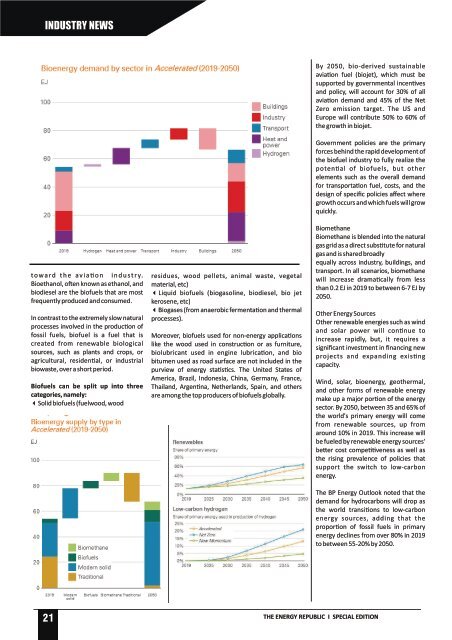The Energy Republic February - March Edition 2023
A special publication focused on the Sub-Saharan Africa oil and gas industry with industry updates about the project and investment opportunities in the continent. In this edition, we also featured interesting stories about the energy sector as well as the role of bioenergy resources in the global energy transition agenda, with a spotlight on Germany's biofuel industry, coupled with stakeholders' commentaries and an exclusive interview with Elmar Baumann, Managing Director of the Association of the German Biofuel Industry (VDB).
A special publication focused on the Sub-Saharan Africa oil and gas industry with industry updates about the project and investment opportunities in the continent.
In this edition, we also featured interesting stories about the energy sector as well as the role of bioenergy resources in the global energy transition agenda, with a spotlight on Germany's biofuel industry, coupled with stakeholders' commentaries and an exclusive interview with Elmar Baumann, Managing Director of the Association of the German Biofuel Industry (VDB).
You also want an ePaper? Increase the reach of your titles
YUMPU automatically turns print PDFs into web optimized ePapers that Google loves.
INDUSTRY NEWS<br />
t o w a r d t h e av i a o n i n d u s t r y.<br />
Bioethanol, o en known as ethanol, and<br />
biodiesel are the biofuels that are most<br />
frequently produced and consumed.<br />
In contrast to the extremely slow natural<br />
processes involved in the produc on of<br />
fossil fuels, biofuel is a fuel that is<br />
created from renewable biological<br />
sources, such as plants and crops, or<br />
agricultural, residen al, or industrial<br />
biowaste, over a short period.<br />
Biofuels can be split up into three<br />
categories, namely:<br />
3Solid biofuels (fuelwood, wood<br />
residues, wood pellets, animal waste, vegetal<br />
material, etc)<br />
3Liquid biofuels (biogasoline, biodiesel, bio jet<br />
kerosene, etc)<br />
3Biogases (from anaerobic fermenta on and thermal<br />
processes).<br />
Moreover, biofuels used for non-energy applica ons<br />
like the wood used in construc on or as furniture,<br />
biolubricant used in engine lubrica on, and bio<br />
bitumen used as road surface are not included in the<br />
purview of energy sta s cs. <strong>The</strong> United States of<br />
America, Brazil, Indonesia, China, Germany, France,<br />
Thailand, Argen na, Netherlands, Spain, and others<br />
are among the top producers of biofuels globally.<br />
By 2050, bio-derived sustainable<br />
avia on fuel (biojet), which must be<br />
supported by governmental incen ves<br />
and policy, will account for 30% of all<br />
avia on demand and 45% of the Net<br />
Zero emission target. <strong>The</strong> US and<br />
Europe will contribute 50% to 60% of<br />
the growth in biojet.<br />
Government policies are the primary<br />
forces behind the rapid development of<br />
the biofuel industry to fully realize the<br />
poten al of biofuels, but other<br />
elements such as the overall demand<br />
for transporta on fuel, costs, and the<br />
design of specific policies affect where<br />
growth occurs and which fuels will grow<br />
quickly.<br />
Biomethane<br />
Biomethane is blended into the natural<br />
gas grid as a direct subs tute for natural<br />
gas and is shared broadly<br />
equally across industry, buildings, and<br />
transport. In all scenarios, biomethane<br />
will increase drama cally from less<br />
than 0.2 EJ in 2019 to between 6-7 EJ by<br />
2050.<br />
Other <strong>Energy</strong> Sources<br />
Other renewable energies such as wind<br />
and solar power will con nue to<br />
increase rapidly, but, it requires a<br />
significant investment in financing new<br />
projects and expanding exis ng<br />
capacity.<br />
Wind, solar, bioenergy, geothermal,<br />
and other forms of renewable energy<br />
make up a major por on of the energy<br />
sector. By 2050, between 35 and 65% of<br />
the world's primary energy will come<br />
from renewable sources, up from<br />
around 10% in 2019. This increase will<br />
be fueled by renewable energy sources'<br />
be er cost compe veness as well as<br />
the rising prevalence of policies that<br />
support the switch to low-carbon<br />
energy.<br />
<strong>The</strong> BP <strong>Energy</strong> Outlook noted that the<br />
demand for hydrocarbons will drop as<br />
the world transi ons to low-carbon<br />
energy sources, adding that the<br />
propor on of fossil fuels in primary<br />
energy declines from over 80% in 2019<br />
to between 55-20% by 2050.<br />
21<br />
THE ENERGY REPUBLIC I SPECIAL EDITION















